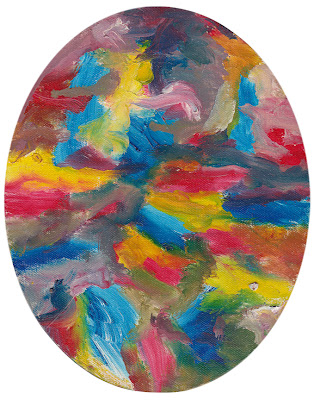Joe Glasco
I met the artist Joseph Glasco when I was studying at the School of the Art Institute of Chicago. One break we drove to New York with some friends for my first visit. A friend from my home town, Houston, had given me Joe's name so I could look him up when I got there. I had no idea who he was. Joe was living in the heart of Soho on Greene street that was his home and studio. We met and it was the start of a friendship that lasted until his death in 1996.
Below is a polaroid I took of Joe back in the 80's that captures some essential aspects of his personality and taste. He had a love for water and equated it with the essentials needed for survival, imparting it with an almost mystical importance akin to what one might read in the Tao. For though water is without shape it has the ability to erode solid stone and assume any shape it desires. He drank it religiously as an essential ingredient for his health but it was also symbolic of other virtues he admired. He had a beautiful carafe that was the receptacle of this elixer. Also consistent with Joe's nature, was that he only drank tap water- he always repeated the fact that New York City had some of the best tasting water in the world.
Below is a polaroid I took of Joe back in the 80's that captures some essential aspects of his personality and taste. He had a love for water and equated it with the essentials needed for survival, imparting it with an almost mystical importance akin to what one might read in the Tao. For though water is without shape it has the ability to erode solid stone and assume any shape it desires. He drank it religiously as an essential ingredient for his health but it was also symbolic of other virtues he admired. He had a beautiful carafe that was the receptacle of this elixer. Also consistent with Joe's nature, was that he only drank tap water- he always repeated the fact that New York City had some of the best tasting water in the world.
By the mid 90's he had left New York and was living at his other home and refuge in the city of Galveston, Texas. He had a spacious studio on the main drag in Galveston called the Strand where he could be close to the ocean and away from prying neighbors. He also had a home in the Victorian section of Galveston that had beautiful stained glass windows throughout and fine hard wood of the period.
In the Summer of 1994, my grandmother, who lived in Houston, and I visited Joe with my Mother. He had a genuine affection for women of her age and experience. She must have reminded him of someone important in his own life and the simplicity of life in the Southwest. My grandmother had an innocence and lack of guile that was refreshing to Joe who had risen in the ranks of people like Clement Greenberg and Jackson Pollock. She brought back memories of his roots in Tyler, Texas, Joe's version of Orson Welles and "Rosebud." It was during this visit that Joe gave the painting pictured below to her, which he let me pick out.
This painting was atypical for Joe as it was not a collage and was painted with oils. It still bore many of the traits that were characteristic of his style that was partially a result of his friendship and influence of Jackson Pollock, in particular the All-over style and fluctuation of foreground and background. Joe was equally comfortable working in the traditional heroic scale of the Abstract Expressionists or his more intimate version as this painting illustrates, being only around 8 x 10 inches.




I used to work as a studio assistant for Joe back in the early nineties. He was as kind and unassuming as he was talented. I learned so much from him during our time together. He truly was an amazing man.
ReplyDelete